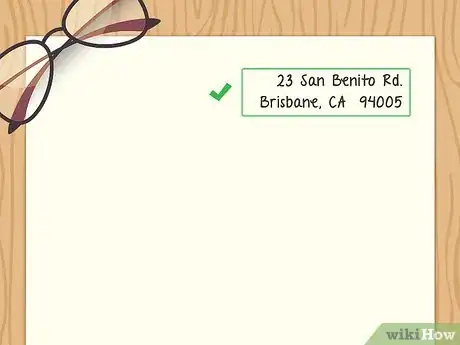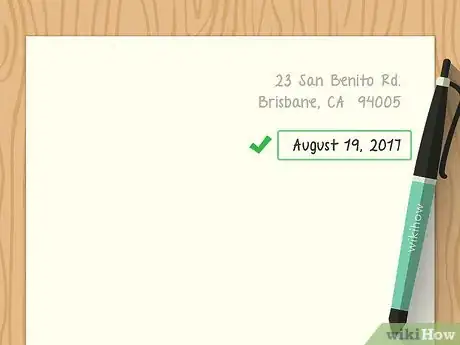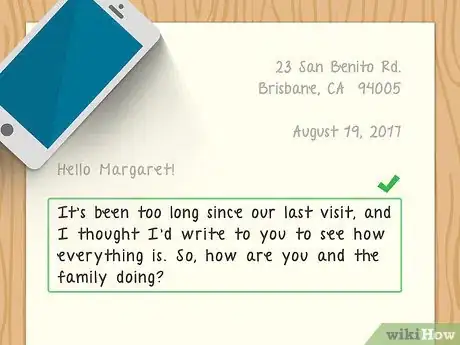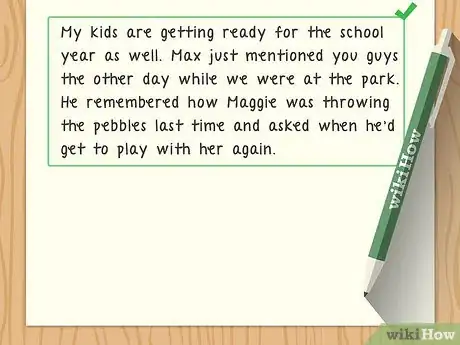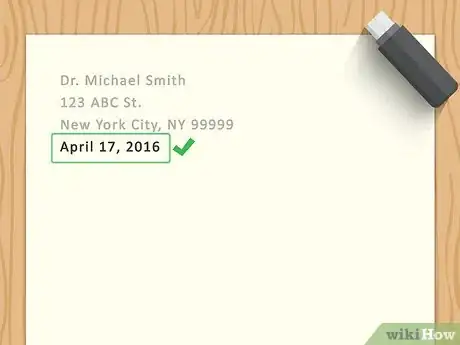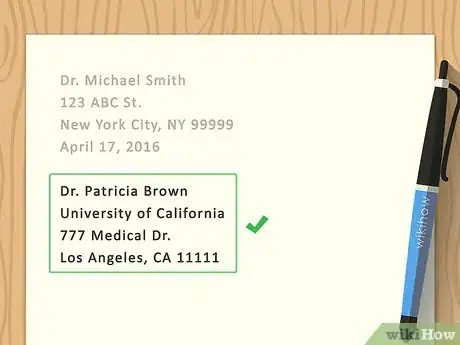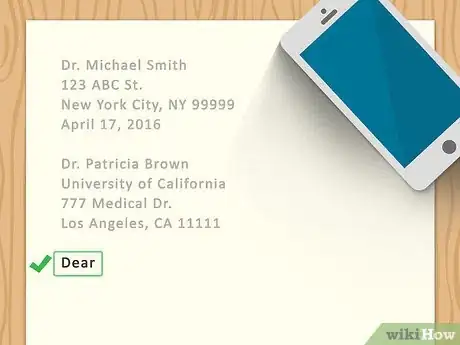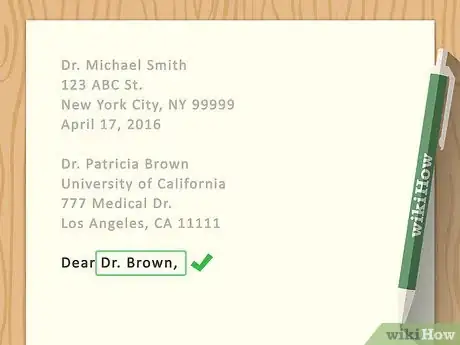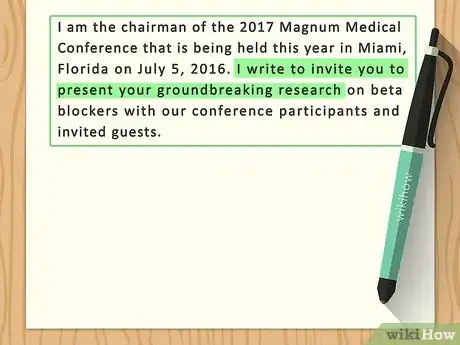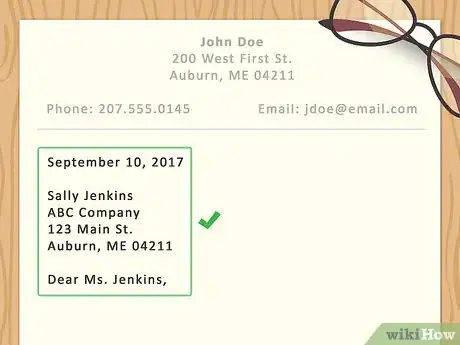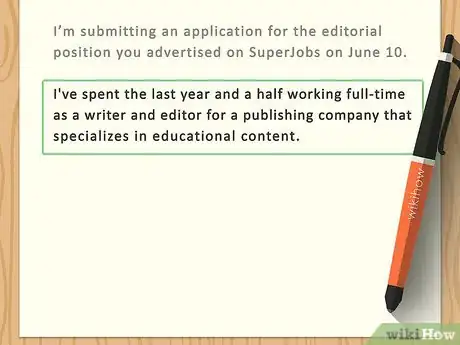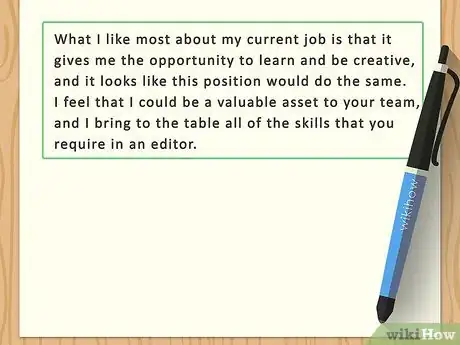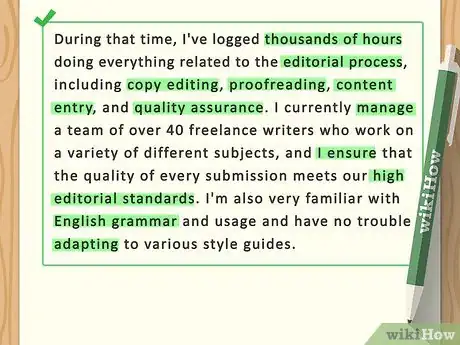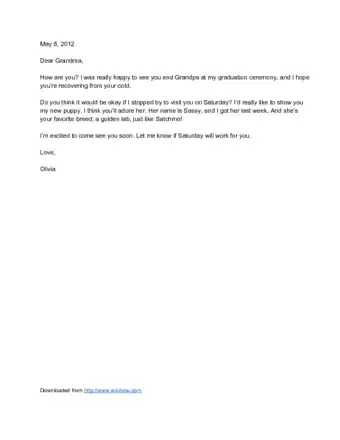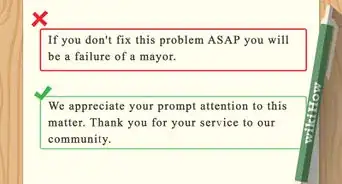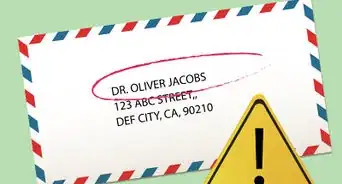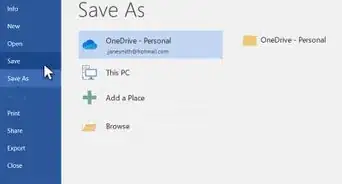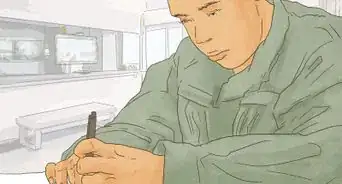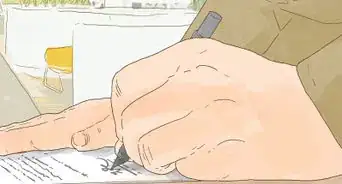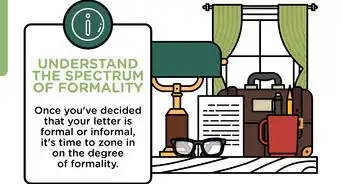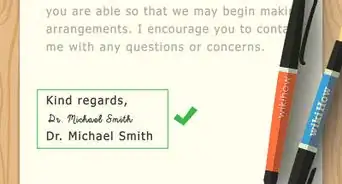This article was co-authored by Tami Claytor. Tami Claytor is an Etiquette Coach, Image Consultant, and the Owner of Always Appropriate Image and Etiquette Consulting in New York, New York. With over 20 years of experience, Tami specializes in teaching etiquette classes to individuals, students, companies, and community organizations. Tami has spent decades studying cultures through her extensive travels across five continents and has created cultural diversity workshops to promote social justice and cross-cultural awareness. She holds a BA in Economics with a concentration in International Relations from Clark University. Tami studied at the Ophelia DeVore School of Charm and the Fashion Institute of Technology, where she earned her Image Consultant Certification.
This article has been viewed 652,135 times.
A letter that has a strong start is more likely to make a good impression on your reader. Whether you are preparing to write a personal letter, a business letter, or a cover letter, it can be hard to know how to structure the heading and what to say in the first few lines. If you need to learn about the correct format for a letter or come up with an excellent way to open your letter, there are some specific conventions and strategies that may help you.
Steps
Starting a Personal Letter
-
1Include your address on upper right side of the letter. For a personal letter, place your address on the upper right hand side of your paper. This will make it easier for your recipient to respond to you because he or she will not have to look up your address or save the envelope.
- You do not need to include your name in the address. Just include your street address or PO box on the first line and then include your city, state, and zip code on the next line.
-
2Provide the date after your address. It is important to include a date so that your recipient will know when you composed your letter. Including a date can also be useful if your recipient wants to save the letters he or she receives and organize them by date. Place the date on the next line after your address.[1]
- Write out the date with the Month first, then the date, and then the year. For example, “April 22, 2023.”
Advertisement -
3Address your recipient. Next, you will need to skip a line and move over to the left side of your page. You should always use the salutation “Dear” to begin personal letters. Follow “Dear” with your recipient's name and a comma.
- Consider how you usually address your recipient when you talk to him or her. For example, you might address your recipient as, “Dear Stephanie,” “Dear Grandma,” or “Dear Mr. Thompson,” depending on how you usually address the person.
- If you're writing to a group of people, like a family, use a greeting like "Hi everyone" to start your letter.
-
4Ask a question. For a personal letter, such as to a friend or family member, opening with a question is a common approach. You can open your letter with a question to show your interest in what the recipient is doing or how he or she has been.
- For example, you could open with something like, “How are you?” or, “How do you like your new school?” or, “Are you feeling better?”
-
5Express your interest in something the recipient said or did. Another good way to start a personal letter is to begin by expressing your interest in something that your recipient put into his or her last letter, such as a recent accomplishment, a fun vacation, or an obstacle that he or she is facing.[2]
- For example, you might start with something like, “Congratulations on your award!” or “Your vacation sounds like it was really fun!” or “I am sorry to hear that you have been having such a bad time at school.”
Starting a Business Letter
-
1Include your address. Your full mailing address should appear at the top of your letter. Do not include your name before the address, but you may include an email address and/or a phone number below the mailing address if desired.[3]
- You may place the address on the right or on the left.
-
2Add the date. After you have written your address and any other contact info that you wish to include, skip a line and include the date. Write out the date in full to include the month, day, and year.[4]
- For example, “April 22, 2016.”
-
3Place your recipient's address on the left hand side. Your recipient's name along with his or her full address should go on the left side of your paper for business letters. Place the address after the date with one space dividing the two.[5]
- Skip a line after your address as well. Your salutation ("Dear ___," or “To whom it may concern,”) goes on the next line.
-
4Decide if “Dear” is appropriate for your purposes. Starting off letters with “Dear” is standard, but it might not always seem appropriate. For example, “Dear” might seem too personal for a complaint letter or for a business correspondence.[6]
- Think about who you are writing to and whether or not using “Dear” suits your purposes. If you are hoping to get to know the recipient better, such as by teaming up on a project, then “Dear” is probably appropriate.
- If including “Dear” makes you uncomfortable, then you can always leave off the “Dear” and just open the letter with the recipient's title and name. For example, you could simply open with “Mr. Parker,” and then follow with your opening line.
- “To Whom it May Concern” is another alternative, but this is even more distant and businesslike than leaving off “Dear.” Only use this opening phrase if you do not know the name of your recipient.
-
5Think about how to address your recipient. Before you write your recipient's name on the letter, take a moment to determine the best way to address him or her. In most cases, business letter should address recipients in a more formal manner, such as by using any titles the person holds. You can also consider how the person has addressed you in letters and your relationship with the person.[7]
- Consider the person's title and position. If the person you are writing to has a special title or position, then you should include this in your Salutation. For example, if the person is a doctor, then you might begin your letter with “Dear Dr. Jones.” If the person is a general in the military, then you might begin your letter with “Dear General Wilson.” People who have a PhD or LLD at the end of their names should also be addressed as Dr.
- Check the letter you are responding to. If you are writing a letter in response to another letter, then checking to see how you were addressed may help you to decide how to address your recipient. For example, if the letter you received starts with “Dear Ms. Johnson,” then you should also start your letter with “Dear Mr./Mrs./Ms. ____.”
- Think about how well you know the recipient. You may also want to consider how well you know the recipient when deciding how to address your letter. Are you on a first name basis? Or do you use a title when you address the person? Keep in mind that even if you have called the person by his or her first name in the past, it might be too informal for a business letter. If you are in doubt, err on the side of caution and address the person in a formal manner, such as by including Mr., Ms., or Dr.
-
6Set a pleasant tone. No matter why you are writing, it is a good idea to set a pleasant tone to improve the chances that your recipient will be open to your message. Even if you are writing to complain or for some other unpleasant purpose, never start your letter by saying something rude or demanding. Instead, try expressing well wishes to your recipient or congratulating your recipient on an accomplishment.
- For example, if you want to set a friendly tone in the beginning of your letter, then you might start by saying something like, “I hope this letter finds you well.” Or, “Congratulations on your promotion!”
-
7State your purpose. While it is good to open a business letter in a friendly way, it is also important to get right to the point and state your purpose for writing. You can let your recipient know why you are writing by using a direct, simple template that begins with: “I am writing because/to…”[8]
- You can tailor this opening for a variety of purposes. For example, you might start with something like, “I am writing because of our similar interests,” or, “I am writing to voice a complaint,” or “I am writing to propose a partnership between our companies.”
Starting a Cover Letter
-
1Use business letter format to address your letter and recipient. When writing a cover letter, you can apply the same tactics for addressing the letter as you would with a business letter.[9]
- Include your address on the upper right or left hand side. Do not include your name, just your address.
- Include an email address, personal website address, and/or phone number on the next line.
- Skip a line.
- Provide the date with the month written out. "April 22, 2016"
- Skip another line.
- Include your salutation. "Dear ___," or "To whom it may concern,"
-
2Provide a summary of your accomplishments. It is okay to start a cover letter with something simple, such as “I am writing to apply for X position.” However, if you want to try something a little different to open a cover letter, then you might start with a brief summary of your greatest accomplishments. Offering a brief summary of what you have accomplished can grab the attention of the hiring manager and increase your chance of getting an interview.[10]
- For example, you might start with, “In the past five years, I have doubled my sales and expanded my territory to three neighboring states.” You could then go on to talk more about your professional experience, education, special training, and other qualifications for the job.
-
3Express your enthusiasm. If you are writing a cover letter, then letting your excitement come through on paper can also help to increase your chances of getting an interview. The hiring manager may be impressed by your dedication to your job.[11]
- For example, you could say something like, “I was excited to see this job posting because I have always been a big fan of your company.” You could then go on to explain what you like about the company, why you are so passionate about your work, and how you think you would fit in.
-
4Incorporate relevant keywords. Keywords may be helpful if you know that you will be up against lots of other people for a job. Mentioning keywords early in your letter can increase the chances that your application will be noticed, especially if those keywords indicate that you might be a good fit for the job.[12]
- Some good keywords to mention include those that appear in the job posting, such as specific skills or experience that you possess. For example, you might begin with something like, “In my five years as a sales manager, I have given regular presentations, developed successful sales strategies, and written numerous sales scripts for my employees.”
- You can also mention the names of any person or persons who referred you to this position. This might catch the attention of the hiring manager and ensure that you get an interview. For example, you might write something like, “I heard about this position from our department chair, Dr. Smith.”
Expert Q&A
-
QuestionHow do you start a thank you note?
 Tami ClaytorTami Claytor is an Etiquette Coach, Image Consultant, and the Owner of Always Appropriate Image and Etiquette Consulting in New York, New York. With over 20 years of experience, Tami specializes in teaching etiquette classes to individuals, students, companies, and community organizations. Tami has spent decades studying cultures through her extensive travels across five continents and has created cultural diversity workshops to promote social justice and cross-cultural awareness. She holds a BA in Economics with a concentration in International Relations from Clark University. Tami studied at the Ophelia DeVore School of Charm and the Fashion Institute of Technology, where she earned her Image Consultant Certification.
Tami ClaytorTami Claytor is an Etiquette Coach, Image Consultant, and the Owner of Always Appropriate Image and Etiquette Consulting in New York, New York. With over 20 years of experience, Tami specializes in teaching etiquette classes to individuals, students, companies, and community organizations. Tami has spent decades studying cultures through her extensive travels across five continents and has created cultural diversity workshops to promote social justice and cross-cultural awareness. She holds a BA in Economics with a concentration in International Relations from Clark University. Tami studied at the Ophelia DeVore School of Charm and the Fashion Institute of Technology, where she earned her Image Consultant Certification.
Etiquette Coach Always say thank you first! Whatever the gesture is, be very specific and say thank you for X, Y, and Z. If you're thanking someone for a gift, explain how it will be used. If you're thanking someone in regards to a job or business interview, say something like "Thank you for your time."
Always say thank you first! Whatever the gesture is, be very specific and say thank you for X, Y, and Z. If you're thanking someone for a gift, explain how it will be used. If you're thanking someone in regards to a job or business interview, say something like "Thank you for your time." -
QuestionHow do you begin writing a complaint letter?
 Tami ClaytorTami Claytor is an Etiquette Coach, Image Consultant, and the Owner of Always Appropriate Image and Etiquette Consulting in New York, New York. With over 20 years of experience, Tami specializes in teaching etiquette classes to individuals, students, companies, and community organizations. Tami has spent decades studying cultures through her extensive travels across five continents and has created cultural diversity workshops to promote social justice and cross-cultural awareness. She holds a BA in Economics with a concentration in International Relations from Clark University. Tami studied at the Ophelia DeVore School of Charm and the Fashion Institute of Technology, where she earned her Image Consultant Certification.
Tami ClaytorTami Claytor is an Etiquette Coach, Image Consultant, and the Owner of Always Appropriate Image and Etiquette Consulting in New York, New York. With over 20 years of experience, Tami specializes in teaching etiquette classes to individuals, students, companies, and community organizations. Tami has spent decades studying cultures through her extensive travels across five continents and has created cultural diversity workshops to promote social justice and cross-cultural awareness. She holds a BA in Economics with a concentration in International Relations from Clark University. Tami studied at the Ophelia DeVore School of Charm and the Fashion Institute of Technology, where she earned her Image Consultant Certification.
Etiquette Coach State only the facts—leave emotion out of it. You may be very upset, but whoever you're sending this letter of complaint to doesn't need that because it's going to overshadow the real issue. Instead, be very clear about what your dissatisfied with. For example, you might say "I dined at your restaurant yesterday. Typically, I have a wonderful experience. However, on this particular evening, I had trouble with my server Kate. She took a long time to bring us our food and bill, and she was very curt with us." If possible, put your specific complaint in bullet points.
State only the facts—leave emotion out of it. You may be very upset, but whoever you're sending this letter of complaint to doesn't need that because it's going to overshadow the real issue. Instead, be very clear about what your dissatisfied with. For example, you might say "I dined at your restaurant yesterday. Typically, I have a wonderful experience. However, on this particular evening, I had trouble with my server Kate. She took a long time to bring us our food and bill, and she was very curt with us." If possible, put your specific complaint in bullet points. -
QuestionHow do I write a letter of complaint?
 Community AnswerYou could simply start by stating that you are in disbelief that such bad things would happen at wherever you are filing your complaint.
Community AnswerYou could simply start by stating that you are in disbelief that such bad things would happen at wherever you are filing your complaint.
References
- ↑ https://www.grammarly.com/blog/how-to-write-a-letter/
- ↑ https://owl.purdue.edu/owl/general_writing/personal_correspondence/personal_letters.html
- ↑ https://writing.wisc.edu/Handbook/BusinessLetter.html
- ↑ https://writing.wisc.edu/Handbook/BusinessLetter.html
- ↑ https://writing.wisc.edu/Handbook/BusinessLetter.html
- ↑ https://www.indeed.com/career-advice/career-development/how-to-address-a-formal-letter
- ↑ https://www.indeed.com/career-advice/career-development/how-to-address-a-formal-letter
- ↑ https://owl.purdue.edu/owl/subject_specific_writing/professional_technical_writing/basic_business_letters/index.html
- ↑ https://www.grammarly.com/blog/how-to-write-a-letter/
About This Article
To start a personal letter, always use "Dear" and the person's name or the name by which you address them, like Grandma or Coach, for example. However, if you're writing a business letter, use "Dear" only if you're expecting to have a close relationship with the recipient. Otherwise, drop the "Dear" and just use the person's title and name to open your letter. When you're writing a business or cover letter to somebody unknown, it's okay to use "To whom it may concern" as your opening. For more information about starting letters, including formatting personal, business, and cover letters, scroll down!
